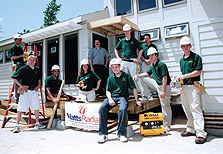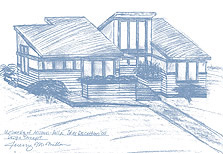

The Missouri-Rolla team builds its Midwest-friendly house.

To broaden the appeal of their design, Missouri-Rolla avoided the ultramodern look of some solar houses.
Solar Decathlon 2005
University of Missouri-Rolla and Rolla Technical Institute
Prairie Solar
"Our way of expanding solar is making it more visually acceptable," says University of Missouri-Rolla student Allison Arnn. Above all else, the Solar Decathlon team from the University of Missouri-Rolla and Rolla Technical Institute wanted to build a house in which any traditional Midwesterner might feel at home.
"It appeals to everyone," team architect and student Adam Tiehes elaborates. "We really believe that's an important thing, especially in our area where people might shy away from something more modern."
One way the house avoids a "solar house" look is that the northern roof has the same pitch as the southern roof. Although the roofline may be more traditional than some solar houses in the competition, one reason the house may be pleasing to the untrained eye is a bit unusual. Everything in the house is designed around a mathematical sequence known as the Fibonacci Sequence, or the Golden Ratio. This sequence can be found in most shapes and patterns in nature, from pinecones to seashells.
The students toyed with the idea of a shell shape for their house, but ever true to their goal of building within a traditional look, they decided to incorporate the sequence in more subtle ways. "While it may not be blatant, it's everywhere you look," says Arnn, who cites the curved kitchen island as an obvious example of the design.
As the team worked toward a more subtle incorporation of the numerical sequence, they looked to Frank Lloyd Wright, who also designed many of his houses using the sequence. "Frank Lloyd Wright's houses protruded out into nature," Tiehes says. "There are 28 windows and two doors in the [Decathlon] house to bring nature in. Our trim in really basic shapes and all natural colors, and our built-ins, all play off his designs."
The house has a standing-seam copper roof, is made out of structural insulated panels, and incorporates a solar thermal/electric panel system the students believe will collect more power than separate systems.
"We are simply not going to show up with the biggest array," says Project Manager and student Joel Lamson, proudly.
Arnn clarifies the team's position on solar panels: "This competition is about doing things efficiently. We think you should take the time and make the effort to do all the math and come up with the optimum amount."
Team Contact
Jeff Birt
1870 Miner Circle
Rolla, MO 65409
573-341-6058
